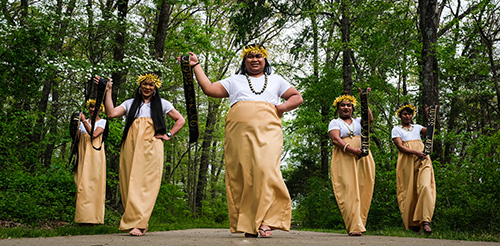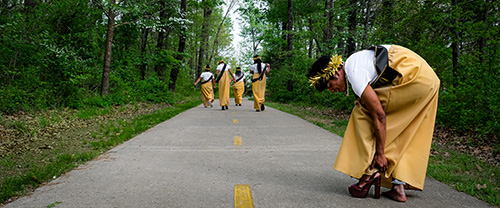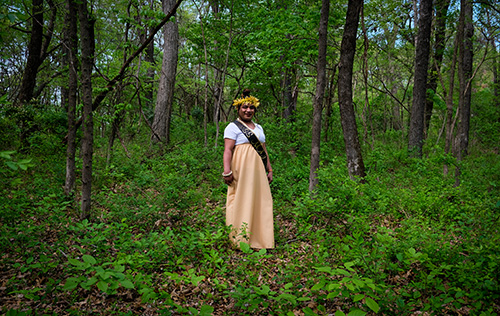Fieldwork
In the Easter of 2023, I conducted fieldwork on the migration of Marshall Islanders to North-West Arkansas. The Marshall Islands were used as a nuclear testing site by the United States between 1946-1958, so as a form of reparation, the Compact of Free Association was signed in 1986, allowing Marshallese citizens to travel, work and live in the United States visa-free. The result of this, has been the creation of ‘a new island’ (as it has often been nicknamed) in a town known as Springdale in North-West Arkansas. This town holds the biggest population of Marshall Islanders beyond their Pacific nation, with an estimated 15,000 Marshallese inhabitants in 2020. Now, with the impending threat of rising sea levels and the potential disappearance of their nation entirely, forced migration has become an even bigger reality. I intended to shine a light on Marshallese perspectives on these key issues and explore how memory, hope and identity are created through educational initiatives and events. The following images are about liminality and the breaking down of taboos, and while not the specific focus of my research, provide a good idea of the challenges and opportunities experienced by some Marshallese groups in their American home.
Taboos and Empowerment
I was fortunate to be in Springdale during the lead up to the much anticipated first ever Marshallese LGBTQ pageant. As a result, I was able to contribute a photoshoot for the contestants a couple of weeks before the big day. Pageantry, although quite a recent ‘westernised’ phenomenon, has become a popular event at Marshallese celebrations with each contestant representing their clan by reciting Marshallese poems or texts and performing a traditional dance. The contestants I photographed are commonly known as kakōļ, men who generally assume women’s roles, often presenting themselves in a feminine fashion. While gender liminality is by no means a recent phenomenon in the Marshall Islands, the conservative, evangelical Christian communities in North-West Arkansas to which many Marshallese people belong to, often convert such practices into taboo, sometimes taking specific action against the inclusion of the LGBTQ community. This event was therefore one of empowerment and celebration on two fronts. A celebration of Marshallese traditions in a diasporic setting and equally one of LGBTQ rights within their own community. I tried to capture this sentiment in the photograph.
“We Live Between Two Worlds”
When moving between locations on our afternoon photoshoot, some contestants would swap out their high heels for their flipflops. Flipflops are known as the stereotypical Marshallese shoe of choice. While in practice, many opt for sneakers, the running joke amongst some of my Marshallese interlocutors was that you could always tell that there were Marshallese people in the next aisle at a grocery store (or ‘Marshallese Walmart’) because of the sound of their flip flops “flap flap flapping” on the floor. Flipflops are a functional choice as most Marshallese houses expect you to remove your shoes when you enter. The stereotype of the flipflop has translated itself beyond the Marshallese community, so much that three of my encounters with non-Marshallese resulted in them exclaiming that they had seen Marshallese people wearing flipflops in the dead of winter a few times. Both flipflops and heels become markers of identity in this photograph. While only a small detail, I found this image an interesting idea, reflecting what one of my Marshallese interlocutors said; “We live between two worlds”.
In a Sea of Green
While not typically ‘ethnographic’ as a photograph, this image reflected many of the conversations which accompanied the photoshoot and the rest of my fieldwork. To truly understand the issues surrounding Marshallese identity in Springdale, one needs to question what the Islands and Ocean mean to Marshall Islanders. Place attachment to the atolls was a fundamental topic amongst my interlocutors, even those who had been born in the United States and never travelled to the Marshall Islands. When referring to the threat of rising sea levels, one community leader told me that “once the foundation of our identity is gone, it’s gone”. The Vice Consulate General then told me “We are nothing without our land”. Both land and ocean are fundamental in connecting Marshallese to ancestral legacy and future generations but also valuable national status. A Marshallese climate activist once told me that the “Ocean is in our blood… the Ocean interweaves our Islands”. Now, more than a thousand miles away from the sea, and over five thousand miles from the Islands, Marshallese people in Springdale are surrounded by the densely forested Ozark Mountains in a new ‘sea of green’.



